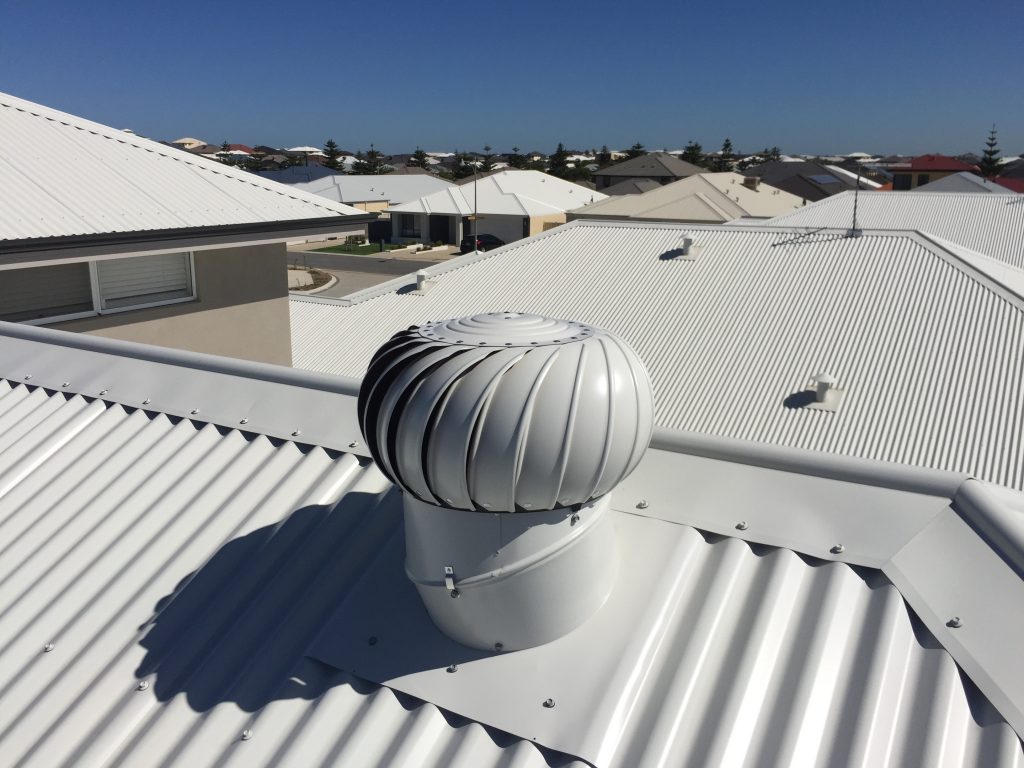DO WHIRLYBIRDS WORK?
Shouldn’t it be obvious? If WhirlyBirds didn’t work, why would they be so common to so many Australian homes?
But just because something is common, does that mean it’s true?
Before you make that investment, you want to be sure you’re not wasting your time and money. Let’s take a look at what WhirlyBirds are; how they work; whether or not they work; and if they do work, how many you need to see the maximum benefits to your home and energy bill.

How Do Roof Vents Work Exactly?
Before we get into WhirlyBirds, let’s quickly talk about what roof vents are and why they are critical to any and all properties. Roof vents are part of a larger roof ventilation system.
Simply put, there are intakes, called soffits, located on the underside of your roof that draw air from the outside environment into your property.
The roof vents act as exhausts that provide outflow for trapped air. This soffit-roof ventilator relationship is a complete roof ventilation system and is critical for all houses.
Why Do You Need Roof Vents?
There are two seasons and one area of your property to think about when discussing roof vents. Summer, winter, and your attic or top floor if you’re interested in a commercial property. The heat trapped in this upper space, in both seasons, can severely affect your wallet.
Summer
During the summer heat gets trapped inside of your upper space; it can often be hotter there than outside. This heat travels downwards into the rest of your property causing more strain on your air-conditioning units and thus driving your electric bill up.
Not only can your electric bill go up, but the extreme temperature build-up can lead to advanced warping and blistering of the roof’s shingles, tiles, or metals. This can lower the product life of your roof and lead to higher maintenance costs over time.
Having ceiling vents on your roof allows the excess heat to escape and lowers temperatures in your property overall as well as extends the life of your roofing materials.
Winter
You might think trapped heat in your upper space–and therefore the rest of your property–would be a benefit to your heating bill. You would be wrong.
In the winter, heat trapped in your upper space melts the snow on your roof–not fully though. That water refreezes in rain gutters blocking them and adds to the moisture sitting on your roof.
The added moisture combined with the heat of your upper space can lead to mould, mildew, rot, and accelerated wear and tear of your roofing structure and materials.
All of this adds to not only higher roof maintenance costs but a possible need for air cleaning within the property if mould becomes a major problem. Having roof vents allows the temperature to balance between your property and the outside environment and will lead to lower maintenance costs overall. Now that we have that preamble out of the way, let’s get to what you’re here about: WhirlyBirds!
What is A WhirlyBird?
A WhirlyBird vent, also known as a ‘turbine vent’, is a type of semi-mechanical vent that can be installed on the roof of a property to help to remove heat and ventilate the roof cavity. WhirlyBirds are particularly popular in Australia, as they work to provide proper roof ventilation in houses that heat up easily.
A very common addition to many Sydney households, WhirlyBirds are just one of the many ventilation systems available. WhirlyBirds do not use any electricity and have been used in Australian homes for years.
With so many ventilation systems out there, it’s important to choose one that is going to improve the air quality of your property and reduce reliance on air conditioning and heating devices.
How Does A WhirlyBird Work?
A WhirlyBird vent is a cylindrical dome that sits on the roof of a building and spins in the wind, creating a vacuum that extracts warm air from the ceiling cavity. It offers an electricity-free solution to managing roof space temperatures.
If you’ve never seen a Standard Box vent, it’s exactly as it sounds: a flattened, cube-shaped box that acts like a mouth or small opening for your property’s roof. There are no moving parts, simply an opening for your roof to breathe. WhirlyBirds are a step up from Standard Box vents.
WhirlyBirds add mechanical fan blades to the insides of the vent casing. And as a result, though the base of WhirlyBirds may be square, the actual vent is more cylindrical and spherical.
This design creates two methods for air exhaust:
A static opening–the same as with a Standard Box vent–and a dynamic solution when the fan blades spin creating a suction effect. Both of these methods rely on cross-ventilation–the natural airflow of the environment.
Installing a WhirlyBird vent is an inexpensive way to make your home more energy-efficient, ventilated, and free from odours and stale air. This means less dependence on air conditioning and heating devices.
If properly maintained, WhirlyBirds can spin for more than 20 years, keeping your property comfortable and clean. This all sounds good. That’s how these guys are designed to work. But do they actually work?
DO WHIRLYBIRDS WORK?
Yes. It’s as simple as that. While not all things common are correct, in the case of WhirlyBirds, there is a reason they are a staple in Australian property construction. They work. They work well. They work often. One caveat though.
We talked earlier about cross-convection–the natural airflow in the environment. If there is no or very low airflow in the environment, the WhirlyBird is as good as a Standard Box vent; you either get a less effective solution or no solution at all from the spinning fans.
If your area doesn’t get enough wind in its weather, you might want to reconsider spending the money on WhirlyBirds and stick with either Standard Box vents or move on to electronic solutions. If the wind isn’t a problem, WhirlyBirds can do wonders for you and your property.
Let’s some up all of this with a simple pro/con list.
The Benefits of WhirlyBirds
- Remove excess heat
- Helps to minimise mould and dampness
- Improves air quality and removes odours
- Cheap to install and free to run
- Saves on air conditioning and heating costs
- Available in Colorbond colours to suit your roof style
The Downsides of WhirlyBirds
- They can be noisy since they do spin
- If installed incorrectly can lead to leaks
- Require natural wind in the environment to move spinning fans
How Many WhirlyBirds Do I Need?
You’re seriously considering going the WhirlyBird route, the next question is, “How many of them do I need?”
This is a pretty common question with a simple solution. The size of your house should determine the number of WhirlyBirds you install. Here’s a rough guide:For roof ventilation installation, the general rule of thumb for square-based venting solutions–that means our WhirlyBird–is one vent for every 300 square feet of your attic or upper space.
If we’re thinking in terms of home property, here are some general numbers:
- 1-2 Bedroom Home: 2 Roof Whirlybird Units
- 3-4 Bedroom Home: 3-4 Roof WhirlyBird Units
- 4-5 Bedroom Home: 4 Roof Whirlybird Units
You now know what WhirlyBirds are, how they work, why you would want them, and how many to buy. Great. How do you install them?
We have that answer:
You’ve done the heavy lifting in getting educated on what you want and why you want it, let us do the heavy lifting when it comes to your WhirlyBird installation.
We are the best providers of roofing and gutter cleaning services throughout New South Wales so please don’t hesitate to call our trusted team of roof and gutter experts. We’re here to help.



